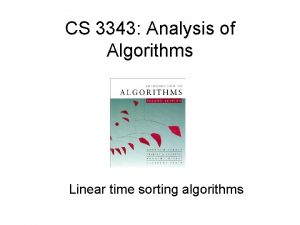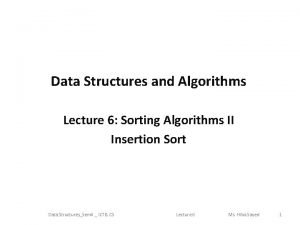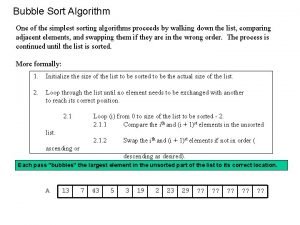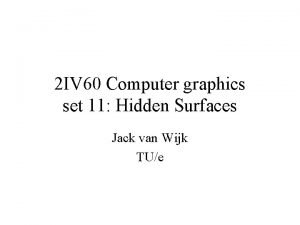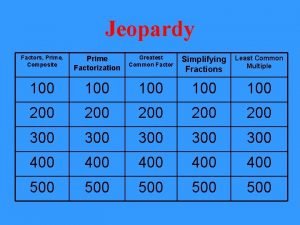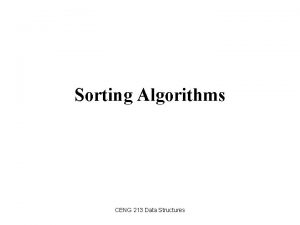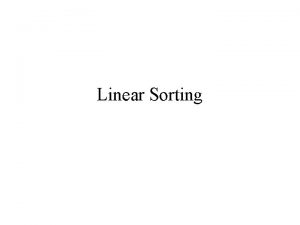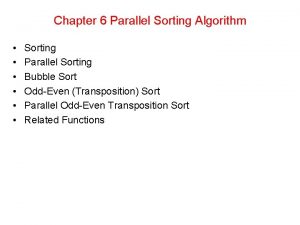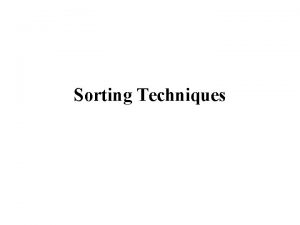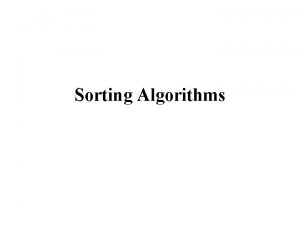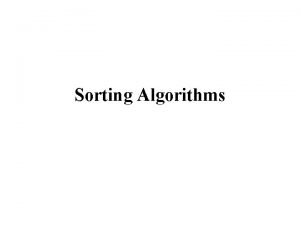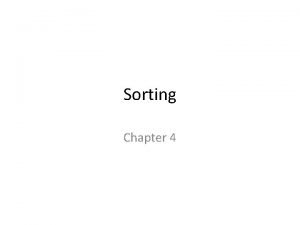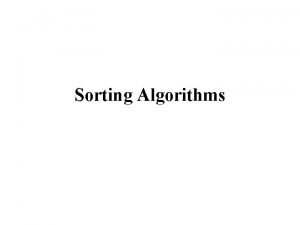CSCD 300 Data Structures Donald Shells Sorting Algorithm













![Shellsort - Code public static void shell. Sort( Comparable[ ] the. Array, int n Shellsort - Code public static void shell. Sort( Comparable[ ] the. Array, int n](https://slidetodoc.com/presentation_image_h/0cf50c1c00d16ac5793fa9ddedccab3b/image-14.jpg)
![Shell. Sort -Trace (gap = 4) [0] [2] [3] [4] [5] [6] the. Array Shell. Sort -Trace (gap = 4) [0] [2] [3] [4] [5] [6] the. Array](https://slidetodoc.com/presentation_image_h/0cf50c1c00d16ac5793fa9ddedccab3b/image-15.jpg)
![Shell. Sort -Trace (gap = 2) [0] [1] [2] [3] [4] [5] [6] the. Shell. Sort -Trace (gap = 2) [0] [1] [2] [3] [4] [5] [6] the.](https://slidetodoc.com/presentation_image_h/0cf50c1c00d16ac5793fa9ddedccab3b/image-16.jpg)
![Shell. Sort -Trace (gap = 1) [0] [1] [2] [3] [4] [5] [6] the. Shell. Sort -Trace (gap = 1) [0] [1] [2] [3] [4] [5] [6] the.](https://slidetodoc.com/presentation_image_h/0cf50c1c00d16ac5793fa9ddedccab3b/image-17.jpg)
- Slides: 17

CSCD 300 Data Structures Donald Shell’s Sorting Algorithm Originally developed by Bill Clark, modified by Tom Capaul and Tim Rolfe 1

Shell Sort - Introduction More properly, Shell’s Sort Created in 1959 by Donald Shell Link to a local copy of the article: Donald Shell, “A High-Speed Sorting Procedure”, Communications of the ACM Vol 2, No. 7 (July 1959), 30 -32 Originally Shell built his idea on top of Bubble Sort (link to article flowchart), but it has since been transported over to Insertion Sort. 2

Shell Sort -General Description Essentially a segmented insertion sort Divides an array into several smaller noncontiguous segments The distance between successive elements in one segment is called a gap. Each segment is sorted within itself using insertion sort. Then resegment into larger segments (smaller gaps) and repeat sort. Continue until only one segment (gap = 1) - final sort finishes array sorting. 3

Shell Sort -Background General Theory: Makes use of the intrinsic strengths of Insertion sort is fastest when: The array is nearly sorted. The array contains only a small number of data items. Shell sort works well because: It always deals with a small number of elements. Elements are moved a long way through array with each swap and this leaves it more nearly sorted. 4

Shell Sort - example Initial Segmenting Gap = 4 80 93 60 12 42 30 68 85 10 10 30 60 12 42 93 68 85 80 5

Shell Sort - example (2) Resegmenting Gap = 2 10 30 60 12 42 93 68 85 80 10 12 42 30 68 93 80 60 85 6

Shell Sort - example (3) Resegmenting Gap = 1 10 12 42 30 60 85 68 93 80 10 12 30 42 60 68 80 85 93 7

Gap Sequences for Shell Sort The sequence h 1, h 2, h 3, . . . , ht is a sequence of increasing integer values which will be used as a sequence (from right to left) of gap values. Any sequence will work as long as it is increasing and h 1 = 1. For any gap value hk we have A[i] <= A[i + hk] An array A for which this is true is hk sorted. An array which is hk sorted and is then hk-1 sorted remains hk sorted. 8

Shell Sort - Ideal Gap Sequence Although any increasing sequence will work ( if h 1 = 1): Best results are obtained when all values in the gap sequence are relatively prime (sequence does not share any divisors). Obtaining a relatively prime sequence is often not practical in a program so practical solutions try to approximate relatively prime sequences. 9

Shell Sort - Practical Gap Sequences Three possibilities presented: 1) Shell's suggestion - first gap is N/2 - successive gaps are previous value divided by 2. Odd gaps only - like Shell method except if division produces an even number add 1. better performance than 1) since all odd values eliminates the factor 2. 2. 2 method - like Odd gaps method (add 1 to even division result) but use a divisor of 2. 2 and truncate. best performance of all - most nearly a relatively prime sequence. 10

Shell Sort - Added Gap Sequence Donald Knuth, in his discussion of Shell’s Sort, recommended another sequence of gaps. h 0 = 1 hj+1 = hj * 3 + 1 Find the hj > n, then start with hj/3 11

Link to the Java program that generated the above data. 12

Shell Sort - Time Complexity Time complexity: O(nr) with 1 < r < 2 This is better than O(n 2) but generally worse than O(n log 2 n). 13
![Shellsort Code public static void shell Sort Comparable the Array int n Shellsort - Code public static void shell. Sort( Comparable[ ] the. Array, int n](https://slidetodoc.com/presentation_image_h/0cf50c1c00d16ac5793fa9ddedccab3b/image-14.jpg)
Shellsort - Code public static void shell. Sort( Comparable[ ] the. Array, int n ) { // shell. Sort: sort first n items in array the. Array for( int gap = n / 2; gap > 0; gap = gap / 2 ) for( int i = gap; i < n; i++ ) { Comparable tmp = the. Array[ i ]; int j = i; for( ; j >= gap && tmp. compare. To(the. Array[ j - gap ]) < 0 ; j -= gap ) the. Array[ j ] = the. Array[ j - gap ]; the. Array[ j ] = tmp; } } 14
![Shell Sort Trace gap 4 0 2 3 4 5 6 the Array Shell. Sort -Trace (gap = 4) [0] [2] [3] [4] [5] [6] the. Array](https://slidetodoc.com/presentation_image_h/0cf50c1c00d16ac5793fa9ddedccab3b/image-15.jpg)
Shell. Sort -Trace (gap = 4) [0] [2] [3] [4] [5] [6] the. Array 80 93 60 12 42 30 68 n: 9 gap: 4 [1] [7] 85 [8] 10 i: j: for( int gap = n / 2; gap > 0; gap = gap / 2 ) for( int i = gap; i < n; i++ ) { Comparable tmp = the. Array[ i ]; int j = i; for( ; j >= gap && tmp. compare. To(the. Array[ j - gap ]) < 0 ; j -= gap ) the. Array[ j ] = the. Array[ j - gap ]; the. Array[ j ] = tmp; } 15
![Shell Sort Trace gap 2 0 1 2 3 4 5 6 the Shell. Sort -Trace (gap = 2) [0] [1] [2] [3] [4] [5] [6] the.](https://slidetodoc.com/presentation_image_h/0cf50c1c00d16ac5793fa9ddedccab3b/image-16.jpg)
Shell. Sort -Trace (gap = 2) [0] [1] [2] [3] [4] [5] [6] the. Array 10 30 60 12 42 93 68 n: 9 gap: 2 i: j: [7] 85 [8] 80 for( int gap = n / 2; gap > 0; gap = gap / 2 ) for( int i = gap; i < n; i++ ) { Comparable tmp = the. Array[ i ]; int j = i; for( ; j >= gap && tmp. compare. To(the. Array[ j - gap ]) < 0 ; j -= gap ) the. Array[ j ] = the. Array[ j - gap ]; the. Array[ j ] = tmp; } 16
![Shell Sort Trace gap 1 0 1 2 3 4 5 6 the Shell. Sort -Trace (gap = 1) [0] [1] [2] [3] [4] [5] [6] the.](https://slidetodoc.com/presentation_image_h/0cf50c1c00d16ac5793fa9ddedccab3b/image-17.jpg)
Shell. Sort -Trace (gap = 1) [0] [1] [2] [3] [4] [5] [6] the. Array 10 12 42 30 60 85 68 n: 9 gap: 1 i: j: [7] 93 [8] 80 for( int gap = n / 2; gap > 0; gap = gap / 2 ) for( int i = gap; i < n; i++ ) { Comparable tmp = the. Array[ i ]; int j = i; for( ; j >= gap && tmp. compare. To(the. Array[ j - gap ]) < 0 ; j -= gap ) the. Array[ j ] = the. Array[ j - gap ]; the. Array[ j ] = tmp; } 17
 Internal vs external sorting
Internal vs external sorting Stable sorting algorithm
Stable sorting algorithm Sorting algorithm
Sorting algorithm Simplest sorting algorithm
Simplest sorting algorithm Cruken
Cruken Quick sort iterative
Quick sort iterative Non-deterministic algorithm
Non-deterministic algorithm Non deterministic algorithm for sorting
Non deterministic algorithm for sorting Insertion sort defination
Insertion sort defination Depth sorting algorithm
Depth sorting algorithm Features of macro processor
Features of macro processor Assembler algorithm and data structures
Assembler algorithm and data structures Data structures and algorithm
Data structures and algorithm 200 200 300
200 200 300 Prime factorization of 200
Prime factorization of 200 100 200 300
100 200 300 200 300 300
200 300 300 200+100+300
200+100+300

